Fardh al-Qanoon, version 1.0
UPDATE: This version of the game has been superseded by version 1.1, which can be found here.
I took a bit of a break from blogging, but in the interim I’ve completed the first version of my conflict simulation, Fardh al-Qanoon. Take a look at the rules, map, and counter sheet, which are followed by my design notes.
As a reminder, this simulation was designed as part of the Conflict Simulation course for King’s College London’s MA War Studies program. My professor, Dr. Philip Sabin, recently released Simulating War, a book that deals with the very topic of the course.
Please feel free to leave comments or email me at mail@smartwar.org with your thoughts.
The Rules
Fardh Al-Qanoon Rules 1.0 on Scribd
Map & Counter sheet
Download Map on Google Docs
Download Counter sheet on Google Docs
Design notes
Fardh al-Qanoon attempts to simulate the 2007 insurgency and counterinsurgency efforts in Baghdad, a complex conflict with a variety of important elements that must be addressed if a simulation is to be useful in any way. The game has gone through several major design changes, with the key theme in each revision being the paring away of complexity while representing the basic dynamic of the insurgency/counterinsurgency. The initial conception of Fardh al-Qanoon involved limited intelligence, a map of Baghdad down to the neighborhood level, and several player values to keep track of (other than units), including factional support, intelligence, Sunni support for the Coalition, Sunni empowerment, Coalition operational capability, Mahdi Army operational capability, and Coalition casualties. There were clearly too many moving parts for a manual simulation, and certainly not all of them were vital to representing the conflict’s essential elements.
Defining the conflict’s essential elements
The first and foremost element of the simulation is the actors involved. In reality, a variety of parties were involved, and the 2010 multiplayer game Battle for Baghdad takes this into account. The Western-led Coalition, Iraqi government, assorted Shia militias (including the Mahdi Army), Sunni militants, foreign militants, and al-Qaeda in Iraq were all players in the 2007 operation. Given the assignment’s constraints and the narrow scope of my simulation (relative to the nationwide insurgency in Iraq as a whole), I felt it was reasonable to have a two-player simulation with the Coalition and Mahdi Army as live actors and the Sunnis of Baghdad represented through game mechanics. In order to prevent the Sunni element of the simulation from being “gamed” (since the rules for its behavior are laid out and known to each player), I included a flexible element of chance that allows player actions to affect the general trend of Sunni actions without specifically determining the outcome. As the Coalition improves its relationship with the Sunni community (advancing the Relations counter on the Coalition-Sunni Relations track), events like terrorist attacks and Sunni-initiated sectarian violence become less likely through a die roll modifier, but they are still possible. After all, the “Sunni Awakening” did not lead to the complete cessation of Sunni sectarian violence, nor is the Sunni faction a unitary actor. While this basic, three-faction formulation involves a good deal of abstraction (essentially placing all non-Shia combatants under the Sunni game faction), I believe it is sufficient for the limited purposes of this simulation.
The second element is the setting. I started with a map of Baghdad and its 89 neighborhoods (combining some neighborhoods together for the sake of simplicity), but it became quickly clear that this was unfeasible for the assignment’s parameters. I reduced this to 25, then 23 larger neighborhood zones that included Sunni areas within them. Even this turned out to be too complex; the first in-class playtest made clear that there were simply too many options for a player to know what they should do in a given situation. In the end, I decided to pare it down to the nine districts of Baghdad, including Sunni neighborhoods as individual spaces within the districts. I believe this solution, in conjunction with the unit mechanics, works well because it presents the geographical setting in a hierarchical (city → district → Sunni neighborhood) rather than lateral manner. A district-level simulation also removes the issue of having to differentiate between individual neighborhoods/zones, which would be difficult to do because of the lack of quality, open-source information about specific areas within Baghdad. Representing the city on a neighborhood-level without this information (neighborhood demographics, level of urban buildup, lines of communication, landmarks, etc.) would mean not being able to answer certain questions, such as “why is neighborhood ‘x’ a hotspot for violence?” or “why is neighborhood ‘y’ so difficult for the Coalition to secure?” Thus, making the map and game simpler also makes it more useful, since it does not seek to tackle questions it cannot plausibly answer.
The third element is what I would call the “field of play.” In most simulations of more traditional battles or operations, this would be the same as the setting. Two or more military forces have a competition of arms over a geographic area, with a result dictated by maneuver and firepower. The field of play in Fardh al-Qanoon is the population rather than strictly territory (a good example of this is the GMT game Andean Abyss). One player can have a superior combat force in an area, but that alone does not determine whether they are in effective control of it. Each player’s relationship with the population at that moment that decides their capabilities. In the initial version of my simulation, this was represented with factional support tracks for each district measuring each player’s level of support from the population, in addition to a separate track altogether for the Sunni population’s support of the Coalition. Altogether, that comes down to 19 individual variables, which somehow sounded like a good idea once. While perhaps not more elegant, my simpler solution was to use Mahdi Stacking Limits, secure/unsecure states, and Manpower Requirements to achieve the same end results that the complicated factional support system would have.
Mahdi Stacking Limits are determined by district demographics and urban density. Heavily Shia areas such as those in eastern Baghdad obviously support more militias, but they have fewer targets that militant Shias would be interested in attacking. On the same note, built-up areas support more militias because of population density and the greater ease of disappearing into the urban terrain. Stacking limits also reflect the Mahdi Army’s status as a non-governmental militia that does not exert perfect command and control of the militants that claim allegiance to it. In an ideal simulation, I would have liked to include a mechanic for militias to sometimes act independent of the Mahdi Army player (e.g. attacking the Coalition in a district rather than staying hidden as the player might have decided to do). In the end, I decided the added complexity such a mechanic would involve (and additional play time required) did not justify the value it would provide. Related to stacking limits are the Mahdi Army’s portion of the Combat Results Table and recruitment mechanism. A Mahdi player gains no benefit from using additional militias in combat after the fifth, since it lacks the command structure necessary for a large militant force to work as a unit. A five militia battle in the game represents a widespread battle throughout a district rather than an intense and overwhelming local battle (this is also why larger engagements are always worse for the Coalition than smaller engagements, where its doctrinal and technological advantages make it only marginally less effective with a smaller force). Mahdi recruitment only occurs in Sadr City, the stronghold of the Mahdi Army and Shia population of Baghdad, and districts that experience an incident of violence (representing Shias who decide to take up arms in the aftermath of a sectarian incident). As the Coalition secures districts and pushes the Mahdi Army back, these mechanisms make it naturally more difficult to raise and use militia units in the “rear” areas of the city. On the other hand, negative developments in a district can be exploited to recruit militias.
Manpower requirements provide the mechanism through which the Coalition interacts with the population. A fully-developed “3x Joint Security Station” counter can only be achieved after at least two months of fully meeting the manpower requirements to secure a district, meaning enough troops to patrol neighborhoods and interact with the population. Ideally, this would mean including a mechanism for ensuring the same units are patrolling a district for a lengthy period of time, since one part of the COIN tactics used in 2007 was that military units would “walk a beat” and become the government’s connection to a local population, similar to a neighborhood’s assigned police officer in a Western city. In addition, the rules currently do not require the manpower requirements to be met in consecutive months, nor is there a provision for JSSs to be “downgraded.” Again, I felt these would add too much complexity to a manual game without providing sufficient simulation value, so they were abstracted: the consequences of an undermanned district are that the area becomes vulnerable to terrorist attack and Sunni violence, and each unit removed from a district represents a greater loss (i.e. removing a battalion before a JSS means losing 1 point of manpower in the district, whereas removing a battalion after having a 3x JSS means losing 3 points of manpower). Manpower requirements also force the Coalition to make difficult choices in its deployments; the districts themselves require a total of 69 points of Manpower to fully secure, while the Sunni neighborhoods require an additional 21 points. By June, the Coalition has 30 points worth of units, which are technically worth 90 if every district has a “3x JSS.” During the early part of the game, the Coalition is faced with several opportunities to choose between focusing on a district as a whole or a Sunni neighborhood, and between focusing on one district versus another. By the end of the game, the Coalition should have more than enough Manpower points to secure the vast majority of the city, but its decisions until that point are crucial, since they determine if the Mahdi Army will have the “Will” necessary to deny the Coalition full victory or even attempt to achieve its own outright victory.
The Units
Ideally, the simulation would use the actual designations of Coalition units deployed in Baghdad between February and November 2007. After compiling a list of the battalions and BCTs involved from order of battle maps by the Long War Journal, I found that there were 39 distinct units (not including Iraqi military or national police) deployed and withdrawn from the city at various points. Given the constraints of the assignment, realistically portraying arrival and departure of individual units would be a cumbersome addition for so little simulation value. Instead, generic battalion and BCT unit counters are used; the arrival and departure of units is abstracted, and instead the ratio and change in troop levels is simulated via the reinforcement mechanism. It should be noted that the unit counters do not represent all government forces in Baghdad, but simply the ones that are available for command. In addition, the Iraqi units are abstracted and are assumed to be operating alongside the commanding Coalition forces.
Reliable information about the Mahdi Army’s manpower and unit formations is sparse; most open source information about them deals with the aftermath of street battles and the results of arrests or raids. Since any calculation of the Mahdi Army’s available manpower is inherently suspect, the simulation is vague in that it represents each militia unit as being a single formation of armed men who work together, while a dispersed militia is the latent ability to raise a formation of armed men quickly. The exact number and armament of these militias is one of the variables of the game that people can debate: how many irregular Shia militants would it take to successfully face off against an American Brigade Combat Team? How many men does it take to clear out a Sunni neighborhood with no Coalition presence? The game defines this in an open-ended way as “1 militia” or “2 militias,” and players can debate what the real-world equivalent of that would have to be.
The Combat Results Table
There are two important outcomes for combat in this simulation: are Mahdi militias successfully driven out of an area, and does the Coalition suffer serious casualties? With that in mind, the Combat Results Table offers a required roll for each event. In order to come up with the values for the table, I read through news stories reporting on clashes between the Coalition and insurgents and reviewed the Department of Defense’s quarterly “Measuring Stability and Security in Iraq” reports for 2007. I came to the conclusion that in small engagements, the Coalition almost always prevailed easily with light casualties, and that widespread resistance was where results were mixed. Since the simulation operates on a district level, the use of more militias in a single combat represents widespread violence. The Mahdi Army can accept lower risk by not using all of its available militias in a combat (and also give itself the opportunity to launch more numerous, smaller attacks), which represents smaller local engagements that the Coalition has an easier time with. In small engagements, the Coalition’s combat chances degrade slightly as its Manpower Points drop; in larger engagements, the degradation is rapid. This gives the Coalition a disincentive against immediately engaging in large, urban street battles with the Mahdi Army to defeat it in one fell sweep. Instead, the best use of its forces is to focus on securing districts, which eventually frees up forces for other missions through the manpower multiplier effect. The Mahdi Army is not in a position to start a large urban battle at the outset of the game either, and must build up its reserve of “Will” by engaging in smaller, local acts of violence against Sunni neighborhoods. By the end of the game, an opportunity for a massive battle in Sadr City or another Shia district arises; the Combat Results Table makes it an iffy proposition for either side, so the decision of whether or not to engage in the battle ultimately rests on the position of each player after their decisions in the early months. For example, if the Coalition neglected the Sunni community earlier in the game, it may find itself needing to secure Sadr City to have enough Victory Points in the end, thus necessitating a large, even more disadvantageous battle there. If the Mahdi Army has saved up enough “Will” by the end to risk trying for an outright victory, it might attempt to hold 2 districts to the end to ensure the Coalition falls short in Victory Points.
The simulation is by no means comprehensive, but I believe the essential elements of the insurgency/counterinsurgency conflict are represented through the game mechanics, and that the game is simple enough without detracting from its purpose. A better simulation (in the sense of providing a more complete model) would go beyond the parameters of the assignment and include more than two players, a larger number of units (to accommodate actual unit designations), and, among other things, a longer allowance for play time. Considering how complicated the initial drafts of the design were, I believe the relative simplicity of the final version is a drastic improvement.

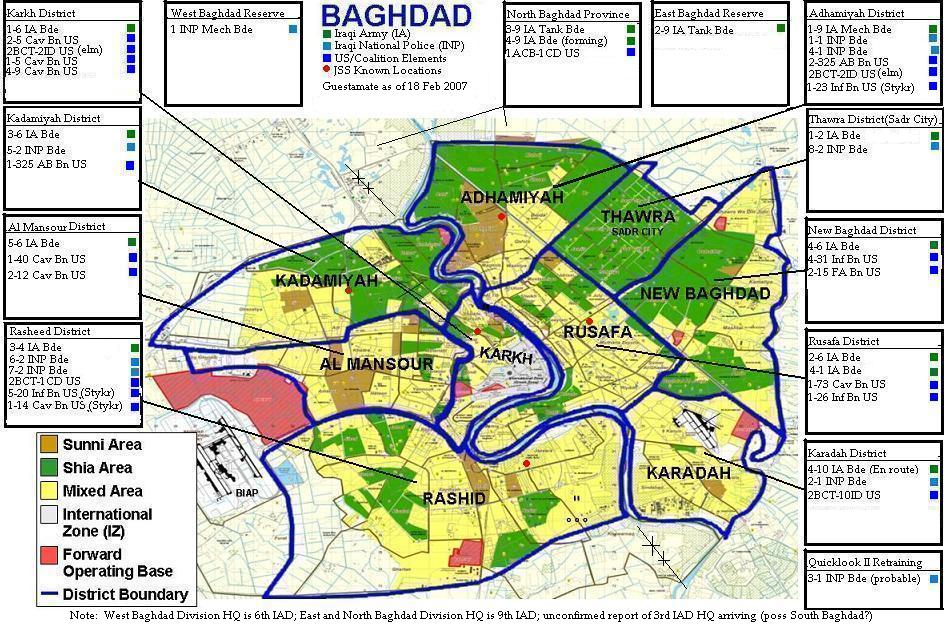
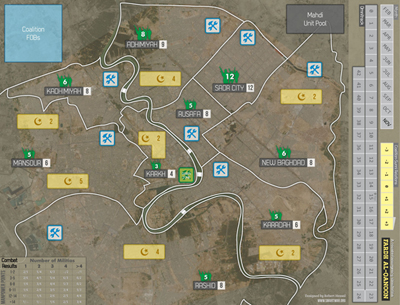
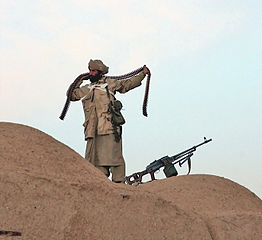



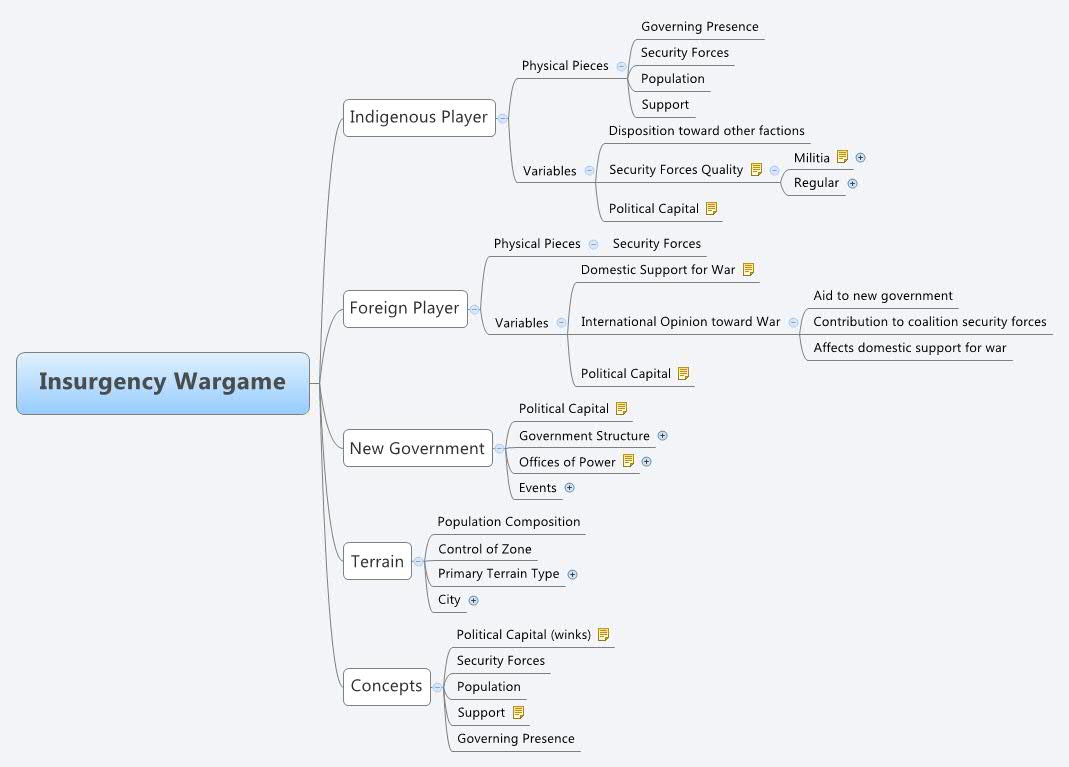
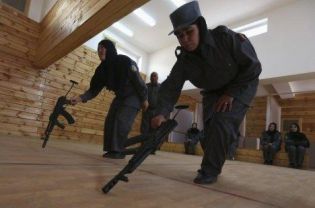


Anyone out there know how to move the Coalition relations track up in favor of the coalition? I can’t seem to find it in the rules.
Thanks
Take care
Peter
Dr. Perla,
I’ve just posted an updated version of my rules that include the missing rule for this. The rule at G-12 has been fixed.
http://www.smartwar.org/2012/07/fardh-al-qanoon-simulation-version-1-1/